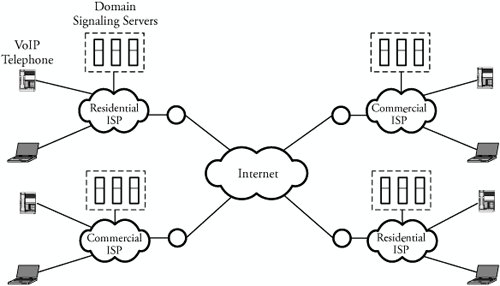Section 18.1. Overview of IP Telephony
18.1. Overview of IP TelephonyAn IP telephone can be used to make telephone calls over IP networks. Voice over IP (VoIP), or IP telephony, uses packet-switched networks to carry voice traffic in addition to data traffic. The basic scheme of IP telephony starts with pulse code modulation , discussed in Chapter 17. The encoded data is transmitted as packets over packet-switched networks. At a receiver, the data is decoded and converted back to analog form. The packet size must be properly chosen to prevent large delays. The IP telephone system must also be able to handle the signaling function of the call setup, mapping of phone number to IP address, and proper call termination. Basic components of an IP telephone system include IP telephones , the Internet backbone , and signaling servers , as shown in Figure 18.1. The IP telephone can also be a laptop or a computer with the appropriate software. An IP telephone connects to the Internet through a wired or a wireless medium. The signaling servers in each domain are analogous to the central processing unit in a computer and are responsible for the coordination between IP phones. The hardware devices required to deploy packet-switched networks are less expensive than those required for the connection-oriented public-switched telephone networks. On a VoIP network, network resources are shared between voice and data traffic, resulting in some savings and efficient use of the available network resources. Figure 18.1. Voice over IP system A VoIP network is operated through two sets of protocols: signaling protocols and real-time packet-transport protocols . Signaling protocols handle call setups and are controlled by the signaling servers. Once a connection is set, RTP transfers voice data in real-time fashion to destinations. RTP runs over UDP because TCP has a very high overhead. RTP builds some reliability into the UDP scheme and contains a sequence number and a real-time clock value. The sequence number helps RTP recover packets from out-of-order delivery. Two RTP sessions are associated with each phone conversation. Thus, the IP telephone plays a dual role: an RTP sender for outgoing data and an RTP receiver for incoming data. 18.1.1. VoIP Quality-of-ServiceA common issue that affects the QoS of packetized audio is jitter . Voice data requires a constant packet interarrival rate at receivers to convert data into a proper analog signal for playback. The variations in the packet interarrival rate lead to jitter, which results in improper signal reconstruction at the receiver. Typically, an unstable sine wave reproduced at the receiver results from the jitter in the signal. Buffering packets can help control the interarrival rate. The buffering scheme can be used to output the data packets at a fixed rate. The buffering scheme works well when the arrival time of the next packet is not very long. Buffering can also introduce a certain amount of delay. Another issue having a great impact on real-time transmission quality is network latency , or delay, which is a measure of the time required for a data packet to travel from a sender to a receiver. For telephone networks, a round-trip delay that is too large can result in an echo in the earpiece. Delay can be controlled in networks by assigning a higher priority for voice packets. In such cases, routers and intermediate switches in the network transport these high-priority packets before processing lower-priority data packets. Congestion in networks can be a major disruption for IP telephony. Congestion can be controlled to a certain extent by implementing weighted random early discard, whereby routers begin to intelligently discard lower-priority packets before congestion occurs. The drop in packets results in a subsequent decrease in the window size in TCP, which relieves congestion to a certain extent. A VoIP connection has several QoS factors:
Packet loss is a direct result of the queueing scheme used in routers. VoIP can use priority queueing , weighted fair queuing , or class-based weighted fair queuing , whereby traffic amounts are also assigned to classes of data traffic. Besides these well-known queueing schemes, voice traffic can be handled by a custom queuing , in which a certain amount of channel bandwidth for voice traffic is reserved. Although the packet loss is tolerable to a certain extent, packet delay may not be tolerable in most cases. The variability in the time of arrival of packets in packet-switched networks gives rise to jitter variations. This and other QoS issues have to be handled differently than in conventional packet-switched networks. QoS must also consider connectivity of packet-voice environment when it is combined with traditional telephone networks. |
EAN: 2147483647
Pages: 211